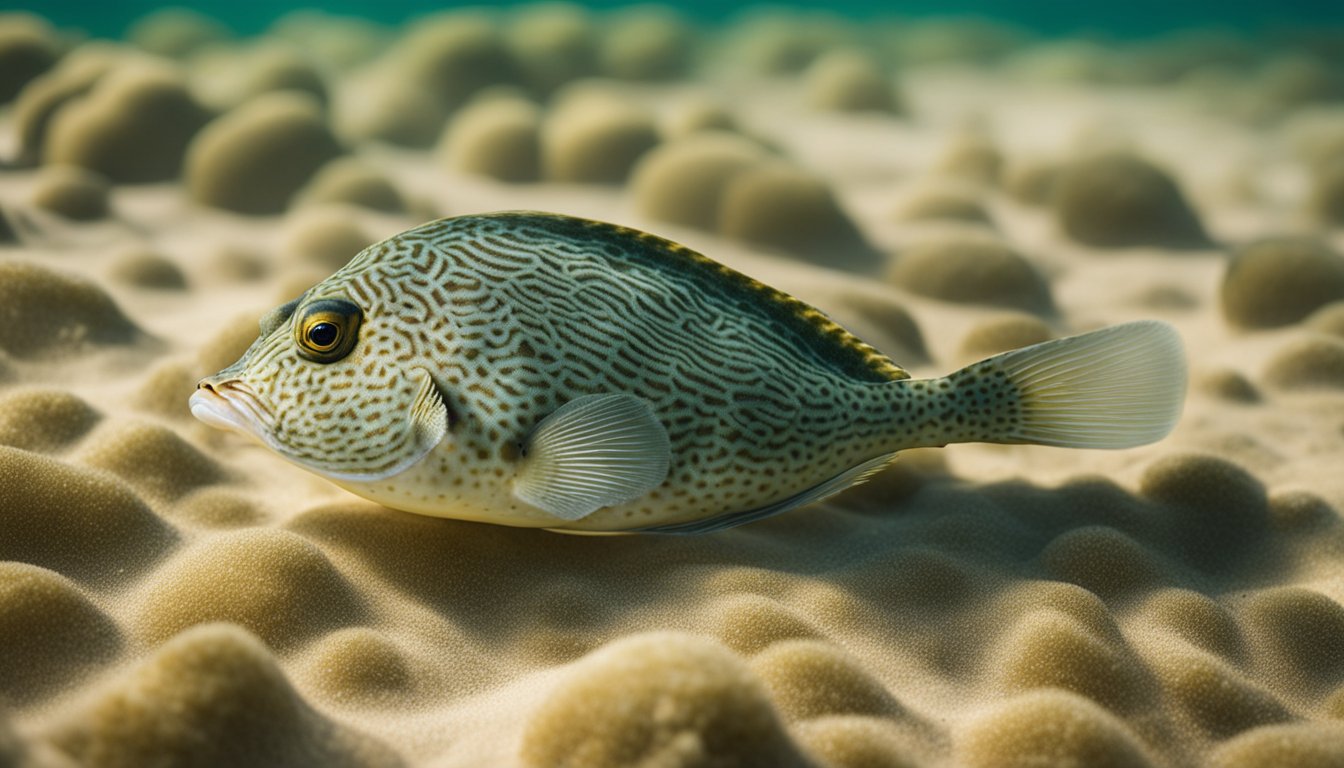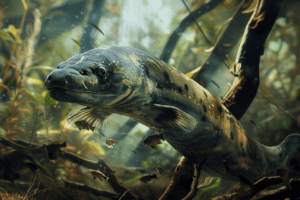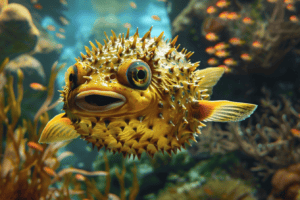The world beneath the waves is a mysterious and fascinating place, filled with creatures that are both strange and beautiful.
Among them is the flounder, a flatfish that lives on the ocean floor.
While it may not be the most glamorous of sea creatures, the flounder is a fascinating animal that has captured the attention of scientists and researchers for years.

Beyond its unassuming appearance, the flounder is a paradoxical creature with many unique features.
For example, it has both eyes on one side of its head, which allows it to blend in with the ocean floor and avoid predators.
It also has the ability to change color and texture to match its surroundings, making it a master of camouflage.
Despite its small size, the flounder is a formidable predator, using its sharp teeth to catch small fish and crustaceans.
In this article, we’ll take a closer look at the world of the flounder, exploring its unique characteristics and behaviors.
From its unusual anatomy to its impressive hunting skills, we’ll delve into the fascinating world of this enigmatic fish.
So, strap on your scuba gear and get ready to dive into the depths of the ocean to discover the secrets of the flounder!
The Flounder’s Mystique

The flounder is a fascinating fish that has captured the imagination of scientists and fishermen alike.
Its unique physical features and behavior have made it a subject of study for centuries.
In this section, we will explore the mystique of the flounder and its paradoxical world.
Anatomy of Deception
One of the most intriguing aspects of the flounder is its ability to camouflage itself.
Its flat and oval-shaped body is covered with small bumps and ridges that mimic the texture of the ocean floor.
The flounder’s skin also changes color to match its surroundings, making it virtually invisible to predators and prey.
The flounder’s eyes are another remarkable feature. Unlike most fish, the flounder has both eyes on one side of its body.
This adaptation allows it to lie flat on the ocean floor and keep an eye out for predators and prey without exposing itself.
The flounder can also rotate its eyes independently, giving it a wider field of vision.
Habitat and Distribution
Flounders are found in oceans and seas around the world, from the shallowest coastal waters to the deepest parts of the ocean.
They are bottom dwellers and prefer sandy or muddy substrates where they can bury themselves.
Some species of flounder can even survive in brackish water, where freshwater and saltwater mix.
Flounders are also known for their ability to migrate long distances. Some species travel hundreds of miles to spawn in specific areas.
The Atlantic flounder, for example, migrates from the Gulf of Mexico to the coast of New England to spawn.
In conclusion, the flounder’s mystique lies in its unique physical features and behavior.
Its ability to camouflage itself and its unusual eye placement make it a fascinating subject of study.
Its habitat and distribution also make it a remarkable species that can survive in a variety of environments.
Survival Strategies

Flounders are masters of survival, and they have developed some unique strategies to thrive in their environment.
These fish have a remarkable ability to blend in with their surroundings, making them nearly invisible to predators.
They also have a complex life cycle that allows them to reproduce and survive in a variety of conditions.
Camouflage and Predation
The flounder’s most impressive survival strategy is its ability to change color and blend in with its surroundings.
This is achieved by specialized skin cells called chromatophores, which can expand or contract to produce different colors and patterns.
When a flounder is resting on the ocean floor, it can change its color to match the sand or rocks around it.
This makes it nearly impossible for predators to spot the fish, and allows it to remain hidden until an opportunity arises to strike.
Flounders are also skilled predators themselves.
They have a unique body shape that allows them to lie flat on the ocean floor, with both eyes on the same side of their head.
This gives them excellent depth perception, and allows them to ambush prey from above.
They are opportunistic feeders, and will eat anything from small fish and crustaceans to worms and mollusks.
Reproduction and Life Cycle
Flounders have a complex life cycle that involves several stages.
They begin life as tiny larvae, which drift in the ocean currents for several weeks before settling on the ocean floor.
Once they have settled, they undergo a metamorphosis, during which one eye migrates to the other side of the head and the fish flattens out.
This allows the flounder to blend in with the ocean floor and become an effective predator.
Flounders are also known for their unique reproductive strategy.
They are broadcast spawners, which means that they release their eggs and sperm into the water column.
The eggs are fertilized externally, and the larvae drift in the ocean currents until they settle on the ocean floor.
This allows flounders to reproduce in a variety of conditions, and ensures that their offspring have the best chance of survival.
In conclusion, flounders are remarkable fish that have developed some unique survival strategies to thrive in their environment.
Their ability to blend in with their surroundings and their complex life cycle have allowed them to become successful predators and reproduce in a variety of conditions.
Human Interactions

Fishing and Cuisine
Flounders are a popular food source for many cultures around the world.
The flat, oval-shaped fish can be found in both freshwater and saltwater environments, making them accessible to a wide range of fishing communities.
In fact, flounder fishing is a multi-million dollar industry in many countries, including the United States, Japan, and China.
Flounder meat is prized for its delicate flavor and tender texture, making it a popular ingredient in many cuisines.
In the United States, flounder is often served fried or broiled, while in Japan it is used to make sushi.
In some cultures, the eyes and cheeks of the flounder are considered delicacies.
However, overfishing has led to a decline in flounder populations in many areas.
As a result, some conservation efforts have been put in place to help protect the species.
Conservation Efforts
In recent years, there has been a growing awareness of the need to protect flounder populations from overfishing and habitat destruction.
Many countries have implemented regulations on the fishing of flounder, including size limits and catch quotas.
Some areas have also designated certain areas as marine protected areas, where fishing is prohibited.
In addition to fishing regulations, there are also efforts to restore flounder habitats.
This includes restoring wetlands and other coastal areas that serve as breeding grounds for the fish.
By restoring these habitats, it is hoped that flounder populations will recover and thrive.
Overall, while flounders may be a popular food source, it is important to ensure that their populations are protected for future generations to enjoy.
By implementing fishing regulations and restoring habitats, we can help ensure that these fascinating fish continue to thrive in our oceans and waterways.
Frequently Asked Questions

How does the flounder illustrate the concept of paradox in nature?
The flounder is a perfect example of a paradox in nature. It is a fish that lives on the ocean floor, but it is also a master of camouflage.
Its ability to blend in with its surroundings makes it almost invisible to predators.
The flounder is also a flatfish, which means that it has both eyes on one side of its head.
This adaptation allows the flounder to lie flat on the ocean floor and still see what’s going on around it.
The flounder’s unique characteristics demonstrate the paradoxical nature of the natural world.
Can you explain the unique adaptations of the flounder and their significance?
The flounder has several unique adaptations that make it well-suited to life on the ocean floor.
As mentioned, its flat body and both-eyes-on-one-side-of-its-head arrangement allow it to blend in with its surroundings and keep an eye out for predators.
Additionally, the flounder has a special pigment in its skin that can change color to match its environment, making it even harder to spot.
The flounder’s ability to change color is also used to communicate with other fish and to attract mates.
These adaptations are significant because they allow the flounder to survive and thrive in a challenging environment.
What are some of the most intriguing paradoxes found in marine life?
Marine life is full of paradoxes. For example, the anglerfish is a deep-sea predator that uses a bioluminescent lure to attract prey.
The male anglerfish is much smaller than the female and attaches himself to her body for life.
The male’s only purpose is to fertilize the female’s eggs.
Another example is the mantis shrimp, which has the most complex eyes in the animal kingdom and can see colors that humans can’t even imagine.
The mantis shrimp is also incredibly strong and can punch with the force of a .22 caliber bullet. These paradoxes make marine life endlessly fascinating.
How do scientists approach the study of paradoxical creatures like the flounder?
Scientists approach the study of paradoxical creatures like the flounder with curiosity and a desire to understand how these creatures have adapted to their environment.
They use a variety of tools, including genetic analysis, imaging techniques, and field observations, to study these creatures and learn more about their unique characteristics.
By studying paradoxical creatures, scientists can gain insights into the workings of the natural world and the incredible adaptations that allow creatures to survive and thrive in challenging environments.
What role do paradoxes play in our understanding of the natural world?
Paradoxes play an important role in our understanding of the natural world because they challenge our assumptions and force us to think differently about the creatures and ecosystems around us.
By studying paradoxical creatures, we can gain a deeper appreciation for the complexity and diversity of life on Earth.
Paradoxes also inspire us to ask questions and seek answers, driving scientific inquiry and discovery.
In what ways do flounders challenge our perceptions of normalcy in the animal kingdom?
Flounders challenge our perceptions of normalcy in the animal kingdom in several ways.
For example, the flounder’s flat body and both-eyes-on-one-side-of-its-head arrangement are highly unusual and unexpected.
Additionally, the flounder’s ability to change color and blend in with its surroundings is a remarkable adaptation that challenges our assumptions about what is possible in the natural world.
By challenging our perceptions of normalcy, flounders and other paradoxical creatures inspire us to think differently and explore the mysteries of the natural world.









